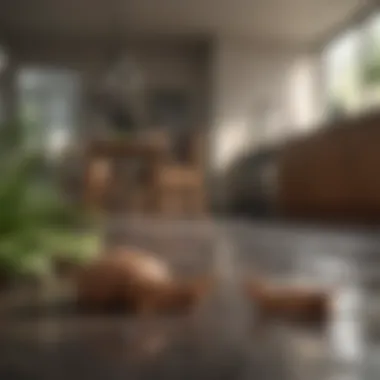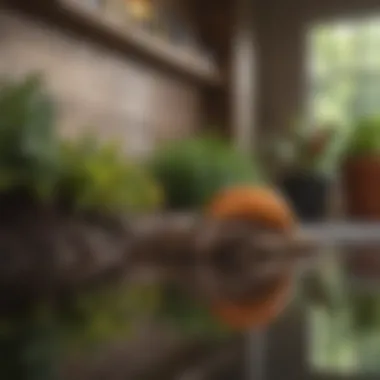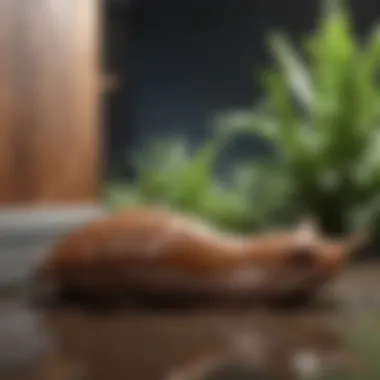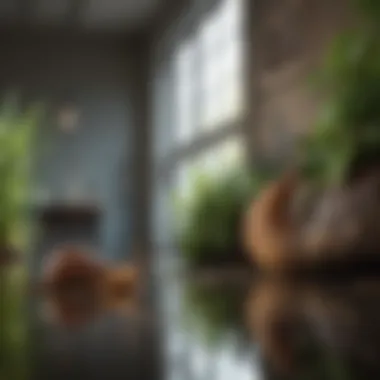Understanding the Impact of Slugs in Residential Spaces


Intro
The presence of slugs in residential spaces often goes unnoticed until they become a bothersome problem. Understanding their behavior and infestation patterns is crucial for homeowners seeking to maintain a clean and healthy living environment. Slugs may appear harmless, but they can contribute to unhygienic conditions and damage to property through their feeding habits.
In this article, we will take a closer look at slugs, exploring their biological traits, behavior, and environmental preferences. We will also identify common causes of infestation in homes. By analyzing these factors, we aim to equip residents with effective strategies for managing and preventing slug-related issues. Let's delve deeper into this often-overlooked topic to better understand the impact slugs have on our residential spaces.
Preface to Slugs
Understanding slugs is crucial for homeowners aiming to maintain a healthy and pleasant living environment. Slugs, despite their often overlooked nature, can have significant impacts. They are not merely garden nuisances but can also invade homes, creating a host of unforeseen problems. Identifying the characteristics and behaviors of slugs provides insight into avoiding infestations and addressing potential damage.
In this section, we will define what slugs are and explore the common species found within residential settings. This knowledge is not just academic; it directly ties to practical measures that can be implemented to mitigate any negative effects. Knowing the threats posed by these creatures enables homeowners to recognize their presence early and take appropriate action.
Defining Slugs
Slugs are soft-bodied gastropods, distinguished by their lack of a visible shell. They belong to the class Gastropoda, which is characterized by a single, spiraled shell in many species. However, true slugs have adapted to environments where having a shell is unnecessary, allowing for greater mobility in moist habitats. They play a specific role in the ecosystem, contributing to the decomposition process by feeding on decaying plant material. Nevertheless, their presence in residential spaces can lead to challenges.
Common Species Found in Homes
Within homes, several species of slugs can be identified. The Common Garden Slug, scientifically known as Arion hortensis, is prevalent in gardens and can often be found in damp, sheltered locations. Another common type is the Brown-Banded Slug, or Limacus flavus, which is known for its distinctive coloration and habit of entering buildings in search of moisture and food.
It is also important to note the Limax maximus, often called the Great Grey Slug. This species is larger compared to others and can cause significant damage to household plants and gardens. Recognizing these species helps homeowners better understand their behavior and the risks they pose.
The Biology of Slugs
Understanding the biology of slugs is essential in managing their presence in residential areas. Their biological characteristics determine their behavior patterns, feeding habits, and preferences in terms of environmental conditions. Knowledge about slugs assists homeowners in recognizing potential signs of infestations and implementing effective management strategies. Further, this awareness aids in maintaining a clean and healthy living space.
Anatomy of a Slug
Slugs are part of the mollusk family and have distinct anatomical features. One significant aspect is their soft, elongated body which lacks a hard shell like that of snails. Their bodies are covered in a slimy mucus that helps with moisture retention and aids in locomotion. This mucosal layer also serves as a protective barrier against predators.
A slug’s body is generally divided into four main parts:
- Mantle: This is a significant area that performs multiple functions, including respiration and sensory perception.
- Foot: A muscular structure at the bottom, enabling movement. It uses a wave-like motion to glide across surfaces.
- Tentacles: Slugs have two sets of tentacles. The upper pair contains their eyes, allowing them to sense light, while the lower pair is used for tasting and touch.
- Respiratory Sacs: Slugs breathe through a respiratory opening located on the right side of their body. This adaptation allows them to remain in moist environments while still obtaining oxygen.
Each of these anatomical features plays a crucial role in the slug's survival and adaptability within human residential spaces.
Reproductive Cycle
The reproductive cycle of slugs is fascinating and impacts their population dynamics significantly. Most slugs are hermaphrodites, meaning they possess both male and female reproductive organs. This unique feature allows a single slug to mate with another if necessary, enhancing their chances of reproduction.
During mating, slugs exchange sperm, which they later use for fertilizing their eggs. After a successful mating encounter, slugs lay clusters of eggs, usually in damp soil or hidden under debris to protect them from desiccation and predators.
The number of eggs can vary, with some species laying up to 80 eggs at one time. These eggs typically hatch within two to four weeks, depending on environmental conditions. The young slugs go through a series of growth stages before reaching maturity.
Lifespan and Growth Stages
The lifespan of slugs can vary across species, commonly ranging between one to five years. However, environmental conditions significantly influence their longevity. Adequate moisture and food availability can lead to healthier and longer-lived individuals.
Slugs undergo several growth stages:
- Egg: As mentioned earlier, after a few weeks, the eggs hatch into juvenile slugs.
- Juvenile: These young slugs are small and lack the full features of adults. They require a moist environment and ample food sources to grow.
- Adult: When they reach maturity, which can take several months, they become capable of reproduction. Adult slugs display full anatomical structure and behaviors.
Overall, understanding the lifecycle of slugs helps homeowners gauge potential infestation risks. Recognizing the stages can indicate when preventive measures are most effective.


Environmental Conditions Favoring Slug Infestations
Understanding the environmental conditions that favor slug infestations is essential for homeowners. Slugs thrive in specific habitats that provide them with the moisture, warmth, and food necessary for their survival. When these conditions are present, slugs can multiply rapidly, leading to significant problems in residential spaces. By recognizing these factors, individuals can take proactive steps to mitigate the risks associated with a slug invasion.
Moisture and Humidity Levels
Moisture is perhaps the most critical factor in slug infestations. Slugs require damp environments to maintain their hydration, as they can quickly lose body moisture through their soft bodies. In residential settings, environments with high humidity levels, often created by over-watering plants or poor drainage, can attract slugs. They enjoy areas such as:
- Garden beds with excessive moisture
- Basements that retain humidity
- Potted plants where water accumulates
Household humidity thresholds above 50% create inviting conditions for these pests. Furthermore, slugs are primarily nocturnal and tend to emerge after rainfalls or during or after the evening when the air is cooler and humidity is higher.
"Moisture levels are crucial; without it, slugs cannot thrive. A simple inspection of garden areas and damp spaces in your home can help identify potential slug habitats."
Temperature Preferences
Alongside moisture, temperature plays a pivotal role in slug activity. In general, slugs prefer temperatures between 50°F and 70°F (10°C to 21°C). Extremes outside this range can be detrimental to them. Here are key points regarding their temperature preferences:
- Cold weather forces slugs into hibernation or dormancy, reducing their visibility.
- Warm weather, particularly heat waves, can lead slugs to seek shelter in cooler, hidden spots within homes or gardens.
A temperature-controlled environment, like heated attics or warm basements, can inadvertently provide slugs with ideal conditions to breed and feed. Homeowners should monitor their living spaces and gardening environments during varying seasons to counteract potential slug populations.
Food Sources: What Attracts Slugs?
Slugs have varied diets, but they primarily feed on soft, decaying organic matter. Their attractions include:
- Leafy greens and tender plants such as lettuce, spinach, and young seedlings
- Fruits and vegetables, particularly overripe or rotting ones
- Moldy substances, as they can break down organic material
Additionally, food spills in kitchens or areas with pet food can be attractive meals for slugs. Creating a clean environment minimizes their food sources and, in turn, limits their presence. By understanding these dietary preferences, homeowners can better protect their spaces from slug infestations.
How Slugs Enter the Home
Understanding how slugs infiltrate residential spaces is a vital aspect of managing these pests. By identifying their entry points and seasonal behaviors, homeowners can take effective measures to prevent infestations. Slugs often enter homes seeking moisture and food, particularly during specific seasons when conditions are favorable. This section provides insights into the common ways slugs gain access to indoor environments and notes their seasonal patterns to inform preventative action.
Common Entry Points
Slugs are highly adaptable creatures that can find numerous ways to enter a home. The most common entry points include:
- Doors and Windows: Gaps beneath doors and windowsills can act as easy access for slugs. Even small openings can allow these creatures to slip inside.
- Cracks and Crevices: Any fissures in walls or foundations provide entry points. Slugs are small enough to navigate through these spaces.
- Vents and Drains: Slugs may also travel through ventilation systems or enter via floor drains, particularly in basements.
- Pipes: If there are cracks in sewage or water pipes, slugs can use these routes to enter the house, especially during wet weather.
Homeowners should conduct regular inspections of these entry points, sealing gaps where possible. Ensuring doors and windows fit snugly can significantly reduce slug intrusions.
Seasonal Trends in Infestation
Slug activity fluctuates with changing seasons, and understanding these patterns is crucial for effective management.
The following trends are observed:
- Spring: As temperatures rise and rainfall increases, slugs become more active. They emerge from hiding spots to feed and reproduce, making it the most common time for infestations.
- Summer: Hot and dry weather may reduce slug activity, but during a period of rain or high humidity, they will thrive. Homeowners may notice them more frequently after storms.
- Fall: Slugs prepare for winter, often seeking shelter indoors as weather turns cooler. This season presents a heightened risk of infestations in homes.
- Winter: Many slugs enter a state of dormancy. However, if they find warm areas within a home, they may remain active, especially in basements or crawl spaces.
Recognizing these seasonal patterns allows homeowners to be proactive. They can implement preventive measures during peak activity periods to deter slugs from entering their living spaces.
"Knowledge of how slugs enter homes and their seasonal behaviors can empower homeowners to take strategic actions for prevention."
By managing entry points and understanding seasonal trends, one can create a less hospitable environment for slugs, thus safeguarding the integrity of the home.


Impact of Slugs on Homes
Understanding the impact of slugs on residential spaces is crucial for homeowners. These creatures, often overlooked, can cause significant damage and lead to health concerns. By acknowledging the implications of slug infestations, homeowners can take proactive measures to protect their properties.
Damage to Property
Slugs feed on various materials, including plants, wood, and other organic matter. When they enter homes, slugs can damage potted plants and garden beds. They leave behind noticeable trails of mucus, which can be unsightly and indicate their presence. In addition to plants, slugs may damage wooden structures, such as furniture and door frames, especially when they are damp. This behavior can compromise the integrity of these materials over time, leading to costly repairs.
Furthermore, the flowers and vegetables in gardens can quickly become targets, resulting in reduced yields and overall aesthetic appeal. Homeowners should remain vigilant; the presence of slugs may require a reassessment of how gardens are managed and maintained.
Hygiene and Health Concerns
The hygiene implications of slug infestations are not to be ignored. Slugs can carry parasites and bacteria that may affect both humans and pets. The most concerning risk is the potential transmission of diseases. Slugs are vectors for various pathogens; for example, they can carry the rat lungworm which can cause serious health issues in humans.
Moreover, the conditions that allow slugs to thrive often result in increased moisture, making homes more susceptible to other pests and mold growth. These factors can contribute to an unhealthy living environment.
Homeowners should regularly inspect areas where slugs are likely to appear, especially in kitchens and gardens. Taking preventive actions and being informed of the potential consequences can enhance the overall hygiene and health of residential spaces.
"Being aware of the potential impacts of slugs on your home can save you from unexpected problems and health risks."
By understanding the consequences of slug infestations, homeowners can implement better prevention strategies and safeguard their living spaces.
Preventative Measures
Preventative measures are crucial for homeowners trying to manage the impact of slugs in residential spaces. These measures not only help in minimizing the chances of a slug infestation but also contribute to maintaining a healthy living environment. By understanding and implementing these strategies, one can ensure that slugs, which might seem harmless, do not proliferate and cause problems in the home.
Environmental Adjustments
Making environmental adjustments is one of the first steps in preventing slug infestations. Slugs thrive in damp and humid conditions. To deter them, it is essential to keep the surroundings dry. Homeowners can take several actions, which include:
- Reducing excessive watering in gardens, particularly during evening hours when slugs are more active.
- Fixing any leaks in pipes or faucets to eliminate standing water.
- Ensuring that gutters and downspouts are functioning well to direct water away from the foundation of the home.
- Trimming bushes and plants to allow for better air circulation, reducing humidity levels.
- Utilizing gravel or sand around garden beds as these materials can deter slug movement.
Altering these environmental factors can significantly decrease the attraction slugs have towards any given area. In addition, regular garden maintenance can remove debris that might serve as a habitat for slugs.
Physical Barriers and Traps
Implementing physical barriers and traps is another effective strategy against slugs. Barriers serve as a preventive measure while traps can aid in managing existing infestations. Some barrier types are:
- Copper tape: When placed around plant pots or garden beds, copper creates a reaction with slug slime, acting as a deterrent.
- Diatomaceous earth: This powdery substance can be sprinkled around plants and is abrasive to slugs, thus preventing them from crossing.
- Sand or crushed eggshells: These can be spread in areas where slugs are suspected, as the rough texture causes discomfort for the slugs.
Setting traps can also efficiently reduce slug populations. A few examples include:
- Beer traps: By filling shallow containers with beer and placing them into the soil, slugs are attracted to the scent and drown in the liquid.
- Simple boards: Laying down wooden boards allows slugs to gather underneath during the day, making them easy to collect.
Using a combination of these physical barriers and traps can create a hostile environment for slugs, deterring them and managing their presence effectively. By taking these preventative steps, homeowners can maintain a healthier living space and protect their properties from potential damage.
Effective Management Strategies
Management strategies are essential for addressing the problem of slugs in residential spaces. Homeowners must comprehend the methods available to reduce slug populations effectively. Employing the right strategies minimizes damage to properties and improves hygiene. As slugs can thrive in various environments, tailored approaches become necessary based on specific household conditions. This section details both chemical control options and natural remedies, providing a comprehensive understanding of each.
Chemical Control Options
Chemical control offers a way to tackle slug infestations effectively. These products often feature specific ingredients designed to eliminate slugs swiftly. Common chemical options include:


- Slug bait: This product usually contains metaldehyde or iron phosphate. It attracts slugs and leads to their death after ingestion. Metaldehyde is effective but requires caution as it can harm pets and wildlife. Iron phosphate is less toxic and is often preferred for residential areas where safety is a priority.
- Diatomaceous earth: This natural yet abrasive powder can be sprinkled around garden areas. It disrupts the slugs' moisture-retaining ability, leading to dehydration. While effective, diatomaceous earth requires reapplication after rain.
- Copper tape: This does not kill slugs but creates a barrier. It operates on the principle that slugs experience a reaction with copper. As they encounter the tape, they are deterred from passing over.
While chemical solutions can be effective, several considerations are crucial:
- Safety: Always read product labels and follow instructions. Safety measures protect not just humans, but also pets and beneficial insects.
- Environmental considerations: Assess the ecological impact of using certain chemicals. Natural options may be preferred for those focused on sustainability.
"The best approach combines chemical control with natural remedies to create a balanced management strategy that suits diverse home environments."
Natural Remedies
Many homeowners prefer natural remedies due to their environmental benefits and safety. These remedies can be quite effective and often involve using common household items or plants. Some popular natural options include:
- Beer traps: Slugs are attracted to the smell of beer. Placing shallow containers filled with beer in gardens can lure them away from plants. This method reduces slug numbers effectively without harming the environment.
- Salt: Though effective at killing slugs by drawing moisture out of their bodies, its use is controversial. Salt can damage the soil and nearby plants, making it a less favorable choice.
- Coffee grounds: Used coffee grounds can act as a deterrent. The caffeine in the grounds is toxic to slugs, and spreading them around the garden helps repel these pests.
- Essential oils: Certain essential oils such as rosemary or peppermint can deter slugs. Mixing them with water and spraying the garden can help keep slugs at bay.
When considering natural remedies:
- Consistency: Frequent application may be necessary for sustained effectiveness.
- Observation: Monitor slug activity to determine the best strategies to use in your space.
Employing a mix of chemical control and natural remedies provides a comprehensive management approach that empowers homeowners to handle slug problems effectively. Putting these strategies into action helps create a healthier home environment.
Case Studies: Successful Slug Management
Case studies provide invaluable insight into the practical implications of implementing management techniques against slug infestations. They serve to demonstrate real-life applications of theoretical knowledge and highlight effective strategies used by homeowners. Understanding how others have tackled this issue not only empowers homeowners but also fosters a sense of community in sharing solutions.
Through case studies, readers can identify specific elements that are critical in managing slug populations. These elements often include the choice of techniques tailored to individual circumstances, assessment of results, and adjustments made throughout the process. By examining these success stories, homeowners can gain a nuanced understanding of what methods are most effective in their own environments.
Residential Application of Management Techniques
In various neighborhoods, homeowners have successfully applied a range of management techniques to control slug populations effectively. For instance, one case involved a suburban garden where slugs were prevalent. The homeowner combined physical barriers and natural remedies, establishing effective control while minimizing harm to the landscape and surrounding ecosystem.
Some specific techniques featured in successful cases include:
- Copper Tape Installations: Homeowners applied copper tape along garden beds. The tape creates a slight electric charge that repels slugs, proving particularly effective near vulnerable plants.
- Diatomaceous Earth: In a case where the homeowner faced an infestation in their vegetable patch, they sprinkled diatomaceous earth around vulnerable areas. This method disrupted the slug's movements, consequently reducing the population over time.
- Beer Traps: Another homeowner shared their experience of placing beer traps within their garden. While slugs were attracted to the beer, they met their demise in the traps, significantly lowering the numbers.
Lessons Learned from Infestations
Case studies offer a repository of knowledge derived from homes that faced slug infestations. Each case reveals critical lessons, which may prove essential in preventing or managing future outbreaks. Homeowners often notice common patterns that yield beneficial insights.
Some key takeaways include:
- Early Intervention is Crucial: Many homeowners emphasized the importance of monitoring and taking action at the first sign of slugs, rather than waiting for an infestation to escalate.
- Combination Approaches Work Best: Strategies that combine several methods—like the use of both natural remedies and physical barriers—tend to yield better results compared to isolated approaches.
- Continuous Assessment and Adaptation: Successful case studies illustrate that ongoing evaluation of the strategies deployed is essential. Homeowners repeatedly adjusted their methods based on observed slug behavior, creating a dynamic management plan.
"Slug management is not a one-size-fits-all solution. Learning from others' experiences can save time and effort in finding the right approach."
By analyzing case studies, homeowners can develop a more effective defense against slugs, ensuring a healthier living environment. Through the trials and errors of others, the journey to successful slug management becomes less daunting and more achievable.
Epilogue
Recap of Key Points
- Defining Slugs: We explored what slugs are and the various species commonly found indoors.
- Biology Insight: Understanding their anatomy, reproductive cycles, and growth stages helps in determining the best management practices.
- Environmental Conditions: We discussed how moisture and temperature can create favorable conditions for slugs, emphasizing the importance of monitoring these levels.
- Entry Points: Common ways slugs invade homes were identified, highlighting prevention tactics.
- Impact on Property: Damage to plants and hygiene concerns were underscored as significant issues.
- Preventative Measures: Environmental adjustments and physical barriers can protect homes from slug infestations effectively.
- Management Strategies: Both chemical and natural remedies have their roles in controlling slugs should infestations occur.
- Case Studies: Real-world examples demonstrated successful strategies and lessons learned in slug management.
These points provide a brief overview of the knowledge necessary for tackling slug-related challenges effectively and maintaining a healthier living environment.
Future Considerations for Homeowners
As we move forward, homeowners should consider a few key elements regarding slugs and potential infestations:
- Continued Education: Staying informed about the biological aspects and behavioral patterns of slugs can lead to better management decisions. Engaging with resources like Wikipedia and Britannica can offer ongoing insight.
- Regular Monitoring: Periodic checks of residential areas prone to moisture or decaying organic matter could prevent potential infestations before they escalate.
- Community Awareness: Homeowners can benefit by sharing knowledge within neighborhoods, discussing what works and what doesn’t, thereby creating a community approach to slug management.
- Adopting Sustainable Practices: Exploring environmentally friendly solutions for controlling slugs aligns with broader ecological goals. Balancing effective slug control with minimal impact on the environment is essential.
Future considerations emphasize an active approach to managing slugs, one that encourages both awareness and action. Homeowners who understand their presence are better equipped to foster a living space that is not only aesthetically pleasing but also healthy and resilient.















